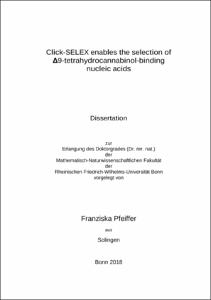Click-SELEX enables the selection of Δ9-tetrahydrocannabinol-binding nucleic acids

Click-SELEX enables the selection of Δ9-tetrahydrocannabinol-binding nucleic acids

| dc.contributor.advisor | Mayer, Günter | |
| dc.contributor.author | Pfeiffer, Franziska | |
| dc.date.accessioned | 2020-04-26T12:46:17Z | |
| dc.date.available | 2020-04-26T12:46:17Z | |
| dc.date.issued | 10.05.2019 | |
| dc.identifier.uri | https://hdl.handle.net/20.500.11811/7914 | |
| dc.description.abstract | Δ9-Tetrahydrocannabinol (THC) is the main psychoactive compound in the plant Cannabis sativa and the most widely used illegal drug in the world. Its consumption impairs driving skills such as keeping a vehicle on track and has been shown to increase the risk of accidents. Urine tests are available for the detection of THC in a roadside setting, but necessitate facilities and are prone to sample manipulation. In addition, the correlation between impairment and positive tests is poor as a THC-metabolite instead of the active THC is analysed. Oral fluid sampling has emerged as a simple and quick alternative that permits detection of THC itself and therefore evidence for driving under the acute influence of THC. Existing oral fluid tests that are based on antibodies fail to reach the sensitivity and specificity needed for roadside testing. We aimed to select a THC-binding aptamer for the development of new oral fluid tests for THC. Aptamers are single-stranded nucleic acids that specifically recognise their target molecule with high affinity. Numerous trials with both DNA and 2'F-modified RNA did not succeed in enriching such sequences for THC. Most likely, this is due to the high hydrophobicity of THC and its thereby constrained ability to interact with nucleic acids. Nucleobase-modified aptamers have been shown to dramatically increase the selection success for protein targets. We thus used a recently developed technique, called click-SELEX, that facilitates modification of DNA with an azide of choice. Emulating the interaction of THC with the human cannabinoid receptor 1, benzyl- and trifluoromethylbenzyl-residues were utilised as nucleobase-modifications. This enabled the immediate selection of sequences that bind THC immobilised on epoxy-sepharose. While none of the sequences could be shown to recognise THC in solution, this thesis established the synthesis of fluorescently-labelled THC-derivatives that can be utilised in fluorescence polarisation assays to ascertain affinity constants of future clickmers. In addition, THC-solubility in aqueous buffers with low amounts of organic solvent was thoroughly investigated. Altogether, the findings of this thesis lay the foundation for the selection of THC-binding clickmers that can be implemented in roadside tests in the future. | en |
| dc.description.abstract | Click-SELEX ermöglicht die Selektion Δ9-Tetrahydrocannabinol-bindender Nukleinsäuren Δ9-Tetrahydrocannabinol (THC) ist für den Großteil der psychoaktiven Wirkung der Pflanze Cannabis sativa verantwortlich und die meistgenutzte Droge der Welt. Der Konsum beeinträchtigt die Fahrfähigkeit: Fahrzeuge können nicht in der Spur gehalten werden und die Wahrscheinlichkeit von Unfällen steigt. Urintests werden von der Polizei verwendet, können aber verhältnismäßig leicht manipuliert werden und setzen das Vorhandensein von entsprechenden Anlagen voraus. Zusätzlich ist die Korrelation zwischen Einschränkung der Fahrfähigkeit und positiven Ergebnissen schlecht, da ein THC-Metabolit an Stelle des aktiven THCs analysiert wird. Speicheltests sind als eine schnelle und einfache Alternative bekannt geworden, die zudem die Detektion von THC selbst und entsprechend einen viel besseren Nachweis des Fahrens unter akutem Drogeneinfluss gestatten. Die bisher erhältlichen Tests sind Antikörper-basiert, erreichen jedoch nicht die benötigte Sensitivität und Spezifität. Wir wollten ein THC-bindendes Aptamer für die Entwicklung neuer Speicheltests für THC selektieren. Aptamere sind einzelsträngige Nukleinsäuren, die spezifisch und hochaffin ihr Zielmolekül erkennen. Zahlreiche Versuche mit sowohl DNA als auch 2'F-modifizierter RNA konnten keine THC-Aptamere anreichern. Vermutlich ist dies auf die hohe Hydrophobizität THCs und seine dadurch eingeschränkten Möglichkeiten zur Interaktion mit Nukleinsäuren zurückzuführen. Nukleobasen-modifizierte Aptamere konnten die Erfolgsrate von Selektionen für Protein-bindende Aptamere drastisch erhöhen. Entsprechend verwendeten wir eine vor kurzem entwickelte Technik, die sich Click-SELEX nennt, und die Modifikation der DNA mit einem frei wählbaren Azid ermöglicht. Um die Interaktion von THC mit dem humanen Cannabinoid Rezeptor 1 nachzuahmen, wurden Benzyl- und Trifluoromethylbenzyl-Reste als Nukleobasen-Modifikationen verwendet. Dies ermöglichte die sofortige Selektion von Sequenzen, die auf Epoxy-Sepharose immobilisiertes THC erkennen. Obgleich keine der Sequenzen THC in Lösung bindet, etablierte diese Arbeit die Synthese fluoreszenzmarkierter THC-Derivate, welche für die Bestimmung der Affinität zukünftiger Clickmere mit Hilfe von Fluoreszenz Polarisation genutzt werden können. Zusätzlich wurde die Löslichkeit von THC in wässrigen Puffersystemen mit geringen Mengen organischer Lösungsmittel sorgfältig untersucht. Alles in allem legen die in dieser Dissertation dargelegten Ergebnisse das Fundament für die Selektion THC-bindender Clickmere, die in zukünftige Speicheltests implementiert werden können. | en |
| dc.language.iso | eng | |
| dc.rights | In Copyright | |
| dc.rights.uri | http://rightsstatements.org/vocab/InC/1.0/ | |
| dc.subject | Tetrahydrocannabinol | |
| dc.subject | THC | |
| dc.subject | Aptamer | |
| dc.subject | SELEX | |
| dc.subject | CuAAC | |
| dc.subject | Click-Chemie | |
| dc.subject | click-chemistry | |
| dc.subject.ddc | 500 Naturwissenschaften | |
| dc.subject.ddc | 570 Biowissenschaften, Biologie | |
| dc.subject.ddc | 610 Medizin, Gesundheit | |
| dc.title | Click-SELEX enables the selection of Δ9-tetrahydrocannabinol-binding nucleic acids | |
| dc.type | Dissertation oder Habilitation | |
| dc.publisher.name | Universitäts- und Landesbibliothek Bonn | |
| dc.publisher.location | Bonn | |
| dc.rights.accessRights | openAccess | |
| dc.identifier.urn | https://nbn-resolving.org/urn:nbn:de:hbz:5n-54344 | |
| ulbbn.pubtype | Erstveröffentlichung | |
| ulbbnediss.affiliation.name | Rheinische Friedrich-Wilhelms-Universität Bonn | |
| ulbbnediss.affiliation.location | Bonn | |
| ulbbnediss.thesis.level | Dissertation | |
| ulbbnediss.dissID | 5434 | |
| ulbbnediss.date.accepted | 22.03.2019 | |
| ulbbnediss.institute | Mathematisch-Naturwissenschaftliche Fakultät : Fachgruppe Molekulare Biomedizin / Life & Medical Sciences-Institut (LIMES) | |
| ulbbnediss.fakultaet | Mathematisch-Naturwissenschaftliche Fakultät | |
| dc.contributor.coReferee | Förster, Irmgard |
Files in this item
This item appears in the following Collection(s)
-
E-Dissertationen (4400)




